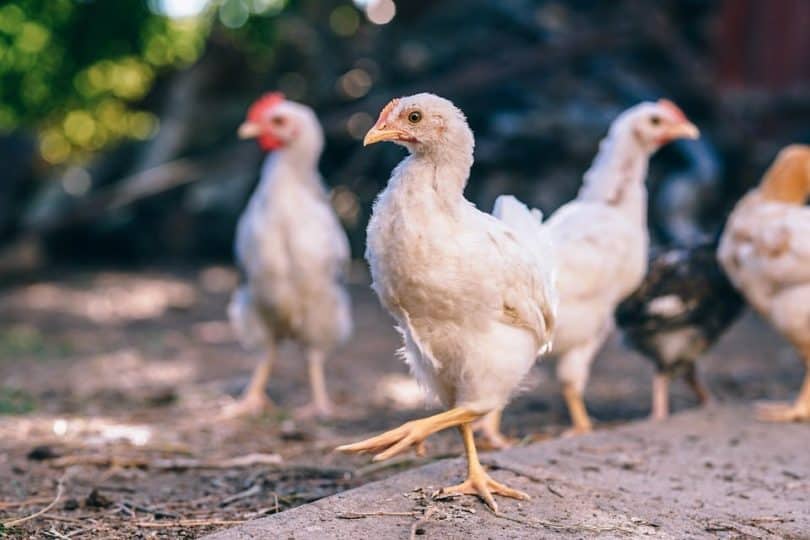Approved by Dr. Luqman Javed
If you have many chickens, you know there will come a time when you need to say goodbye to some and eventually replace those who have gotten old or become sick. However, bringing a strange chicken into the coop can cause quite a stir with your current residents, so you will need to proceed carefully.
If this is the first time you have introduced a new chicken, we’ve created a shortlist that you can use to help reduce the risk of injury and improve the chance of your new chickens settling into a happy home. Join us while we discuss introductions, size differences, mixing breeds, and more to help you create a better life for your birds.

The 3 Steps to Introduce New Chickens to Your Flock
1. Quarantine
If you are purchasing your chicks from a nursery or a reputable dealer, you may be able to skip this first step, but we feel it’s a good idea to quarantine all of your new birds before introducing them to your flock.
The quarantine time will last between 7 and 31 days, depending on several factors, and the longer you wait, the safer it is. The quarantine will help prevent the spread of disease and pathogens to your other birds and will give you a chance to watch and study the new additions for signs of parasites and illness.
What to Look For
Ensure you wash your hands frequently when working with quarantined chickens and watch your birds closely for signs of lice or mites. Examine the comb and see that it is not dull or shriveled and check the legs to see that they are not scaly. You will also want to check that the nostrils aren’t blocked and there is no fluid coming from the eyes.
If you notice any of these signs, contact your vet to see what you can do before introducing the bird to the rest.

- You may also like: Can Ducks and Chickens Live Together?
2. Slow Introduction
Once you are sure that your new chickens are healthy enough to mix with your other birds, you can slowly introduce them. Patience is critical in this step because if you move too quickly, it could lead to fighting and injury. By slow introduction, we mean to allow the birds to look at each other but preventing contact. You will need to allow the slow introduction to take place for at least a week; two is better.
Adjacent Pen
We found the best way to allow the chickens to look at each other is to have an empty pen right next to the main one. The adjacent pen is a perfect solution if you have several birds because you will need to replace them frequently, so you can build this additional pen right from the start. The chickens can see each other and will become familiar without being allowed to fight. Observe their behavior when they’re near each other. If they seem to be wanting to fight through the pens, you might have to use a visual barrier.
Internal Pen
If you only have a few chickens that you keep as pets, several years can go by before you need to replace one, and a second pet may go largely unused. In this case, a small pen placed inside the existing pen will be a good solution, allowing you to use the entire area for one pet but keeping the new chicken separate. The internal pen isn’t a great solution for farms with lots of birds because they can surround the new chicken and intimidate them.
3. Full Introduction
Once you have completed the visual introduction, it will be time to give them the full introduction. Let the chickens loose in the same area and supervise them closely. It is best to do this in the evening before they’re about to turn in for the night. You will see them become aggressive with each other, but this is normal and necessary for them to set up a new pecking order, which is important in the chicken hierarchy. You should only stop it if you see blood or other injuries.
Continue monitoring your birds every day until the jostling ceases quickly and the chickens seem at ease with each other.


Total Introduction Time
When all is said and done, it will take up to a month for the quarantine—1 to 2 weeks for the slow introduction and 3 to 4 days for most full introductions to complete the task of introducing a new chicken to your coop, so around 6 weeks total. As we said earlier, some breeds like the Plymouth Rock and the Cochin are friendly and will accept newcomers much more easily than an Asil chicken, so your total time can vary.
Size Matters
One more thing we want to point out when it comes to chickens is that size matters. If baby chicks hatch naturally, the mother will protect them, but introducing chicks purchased elsewhere can lead to injury and death. You will need to wait at least 16 weeks until the chick grows and then you can follow the same introduction steps we’ve laid out above.
Mixing breeds can also be a problem because of a size difference. Larger chickens will bully smaller chickens, so you can only introduce new chickens of a similar size.

Final Thoughts
Introducing new chickens to your coop is not difficult but will require patience and a keen eye for detecting parasites and other diseases. You will also need to know when to step in and break up a power struggle during the full introduction. The vast majority of chickens only take 2 to 3 days to become acquainted, and it rarely gets to the point where owners need to break it up.
Featured Image Credit: Dietrich Leppert, Shutterstock
